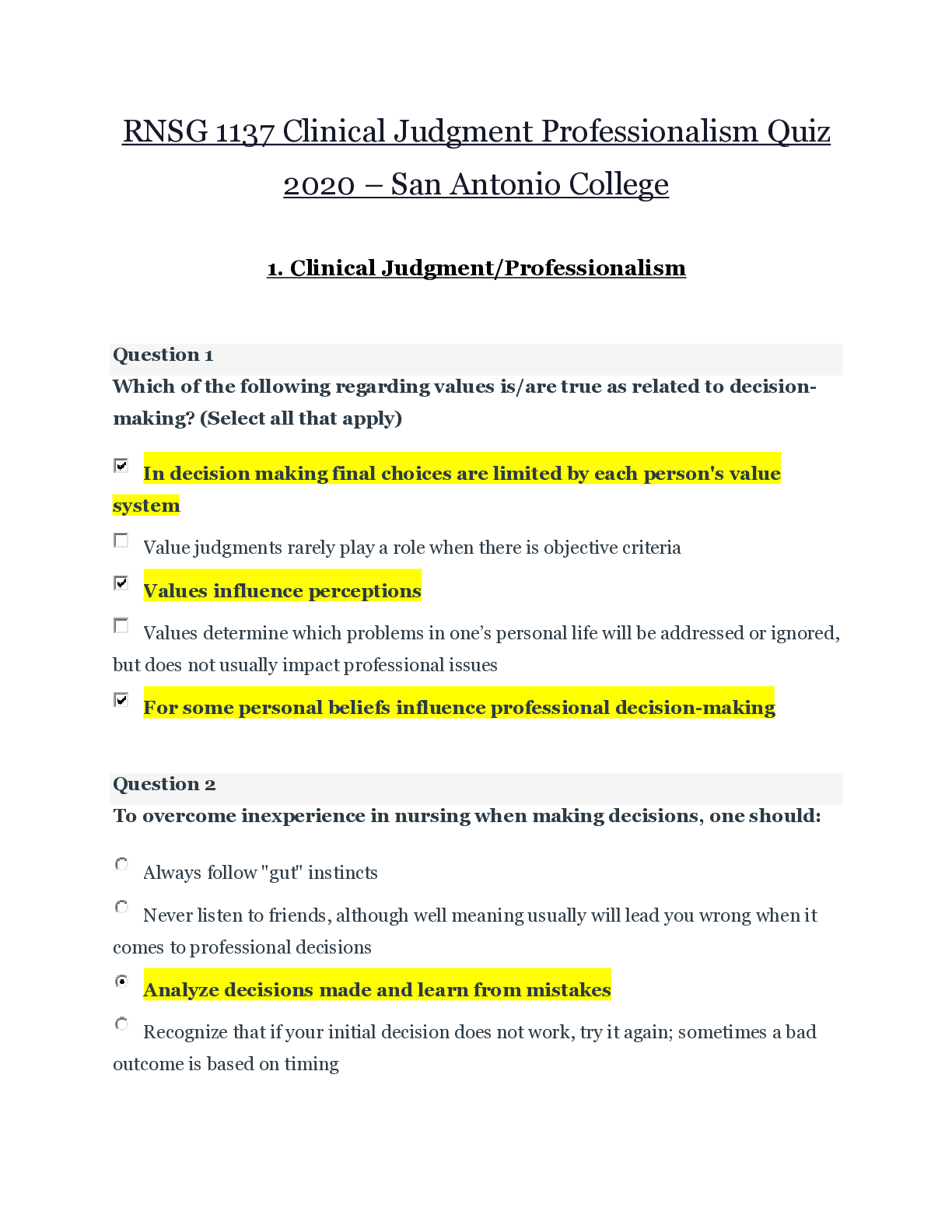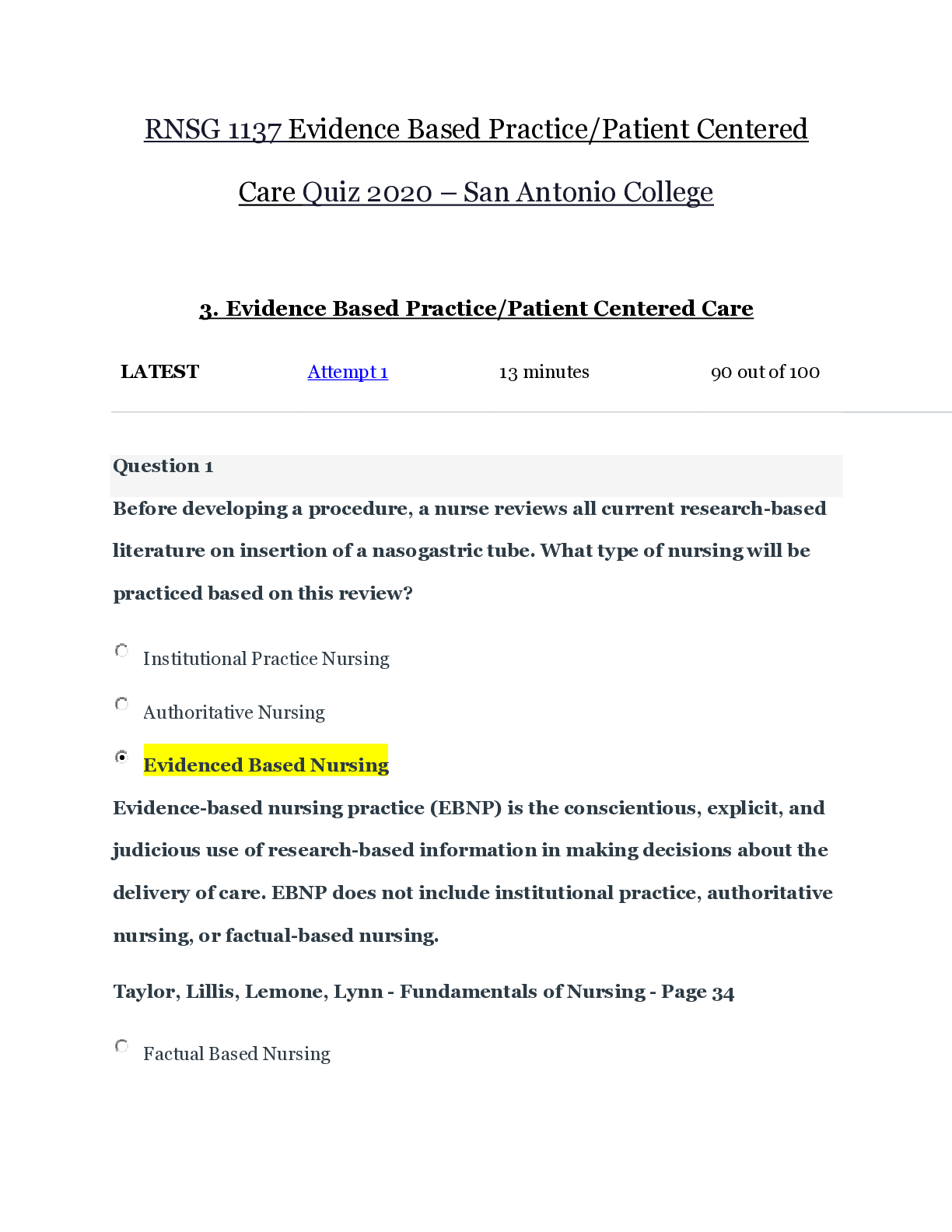*NURSING > EXAM > RNSG 1538 Exam II Questions – San Antonio College | RNSG1538 Exam II Questions (All)
RNSG 1538 Exam II Questions – San Antonio College | RNSG1538 Exam II Questions
Document Content and Description Below
RNSG 1538 Exam II Questions – San Antonio College # Objective Concept/Focus Area 1 5, 6 Reproduction/Maternal Adaptation during Pregnancy/Presumptive Signs Subjective (Presumptive) Signs ... Presumptive signs are those signs that the mother can perceive. The most obvious presumptive sign of pregnancy is the absence of menstruation. Skipping a period is not a reliable sign of pregnancy by itself, but if it is accompanied by consistent nausea, fatigue, breast tenderness, and urinary frequency, pregnancy would seem very likely. 2 5, 6 Reproduction/Maternal Adaptation during Pregnancy/Probable Signs Objective (Probable) Signs Physical Signs Probable signs of pregnancy are those that can be detected on physical examination by a health care provider. Common probable signs of pregnancy include softening of the lower uterine segment or isthmus (Hegar’s sign), softening of the cervix (Goodell’s sign), and a bluish-purple coloration of the vaginal mucosa and cervix (Chadwick’s sign). Other probable signs include changes in the shape and size of the uterus, abdominal enlargement, Braxton Hicks contractions, and ballottement (the examiner pushes against the woman’s cervix during a pelvic examination and feels a rebound from the floating fetus). Pregnancy Tests Along with these physical signs, pregnancy tests are also considered a probable sign of pregnancy. In-home pregnancy testing became available in the United States in late 1977. In-home testing appealed to the general public because of convenience, cost, and confidentiality. Several pregnancy tests are available (Table 11.1). The tests vary in sensitivity, specificity, and accuracy and are influenced by the length of gestation, specimen concentration, presence of blood, and the presence of some drugs. Human chorionic gonadotropin (hCG) is detectable in the serum of approximately 5% of clients 8 days after conception and in more than 98% of clients by day 11 (Shields, 2015). At least 25 different home pregnancy tests are currently marketed in the United States. Most of these tests claim “99% accuracy” according to a U.S. Food and Drug Administration (FDA) guideline or make other similar statements on the packaging or product insert. The 99% accuracy statement in reference to the FDA guideline is misleading in that it has no bearing on the ability of the home pregnancy test to detect early pregnancy (Shields, 2015). The limitations of these tests must be understood so that pregnancy detection is not delayed significantly. Early pregnancy detection allows for the commencement of prenatal care, potential medication changes, and lifestyle changes to promote a healthy pregnancy. TABLE 11.1 SELECTED PREGNANCY TESTS Type Specimen Example Remarks Agglutination inhibition tests Urine Pregnosticon, Gravindex If hCG is present in urine, agglutination does not occur, which is positive for pregnancy; reliable 14–21 days after conception; 95% accurate in diagnosing pregnancy Immunoradiometric assay Blood serum Neocept, Pregnosis Measures ability of blood sample to inhibit the binding of radiolabeled hCG to receptors; reliable 6–8 days after conception; 99% accurate in diagnosing pregnancy Enzyme-linked immunosorbent assay (ELISA) Blood serum or urine Over-the-counter home/office pregnancy tests; precise Uses an enzyme to bond with hCG in the urine if present; reliable 4 days after implantation; 99% accurate if hCG specific Human chorionic gonadotropin (hCG) is a glycoprotein and the earliest biochemical marker for pregnancy. Many pregnancy tests are based on the recognition of hCG or a beta subunit of hCG. hCG levels in normal pregnancy usually double every 48 to 72 hours until they peak approximately 60 to 70 days after fertilization. At this point, they decrease to a plateau at 100 to 130 days of pregnancy. The hCG doubling time has been used as a marker by clinicians to differentiate normal from abnormal gestations. Low levels are associated with an ectopic pregnancy and higher-than-normal levels may indicate a molar pregnancy or multiple-gestational pregnancies (Zinaman, Johnson, & Marriott, 2015). This elevation of hCG corresponds to the morning sickness period of approximately 6 to 12 weeks during early pregnancy. Although probable signs suggest pregnancy and are more reliable than presumptive signs, they still are not 100% reliable in confirming a pregnancy. For example, uterine tumors, polyps, infection, and pelvic congestion can cause changes to uterine shape, size, and consistency. And although pregnancy tests are used to establish the diagnosis of pregnancy when the physical signs are still inconclusive, they are not completely reliable, because conditions other than pregnancy (e.g., ovarian cancer, choriocarcinoma, hydatidiform mole) can also elevate hCG levels. 3 1, 6 Reproduction/Maternal Adaptation during pregnancy/General Body System Adaptations Third-Trimester Discomforts As women enter their third trimester, many experience a return of the first-trimester discomforts of fatigue, urinary frequency, leukorrhea, and constipation. These discomforts are secondary to the ever-enlarging uterus compressing adjacent structures, increasing hormone levels, and the metabolic demands of the fetus. In addition to these discomforts, many women experience shortness of breath, heartburn and indigestion, swelling, and Braxton Hicks contractions. Shortness of Breath and Dyspnea Dyspnea is a common complaint in pregnant women. Physiologic and hemodynamic changes can result in a significant dyspnea in such cases. In some women, dyspnea in normal daily activities can be a sign of heart and lung disease and may be associated with poor perinatal and cardiac outcome in which early detection can prevent adverse events. The increasing growth of the uterus prevents complete lung expansion late in pregnancy. As the uterus enlarges upward in the second and third trimesters, the expansion of the diaphragm is limited. Dyspnea can occur when the woman lies on her back and the pressure of the gravid uterus against the vena cava reduces venous return to the heart (Tara et al., 2015). Explain to the woman that dyspnea is normal and will improve when the fetus drops into the pelvis (lightening). Instruct her to adjust her body position to allow for maximum expansion of the chest and to avoid large meals, which increase abdominal pressure. Raising the head of the bed on blocks or placing pillows behind her back is helpful too. Under normal circumstances, resting with the head elevated while taking slow, deep breaths reduces shortness of breath symptoms. In addition, stress to her that lying on her left side will displace the uterus off the vena cava and improve her breathing. Having the woman periodically stand up and stretch her arms above her head and take a deep breath is helpful to relieve dyspnea. Also, advise the woman to avoid exercise that precipitates dyspnea, to rest after exercise, and to avoid overheating in warm climates. If she still smokes, encourage her to stop. Heartburn and Indigestion Heartburn and indigestion result when high progesterone levels cause relaxation of the cardiac sphincter, allowing food and digestive juices to flow backward from the stomach into the esophagus. Irritation of the esophageal lining occurs, causing the burning sensation known as heartburn. It occurs in up to 70% of women at some point during pregnancy, with an increased frequency seen in the third trimester (King et al., 2015). The pain may radiate to the neck and throat. It worsens when the woman lies down, bends over after eating, or wears tight clothes. Indigestion (vague abdominal discomfort after meals) results from eating too much or too fast; from eating when tense, tired, or emotionally upset; from eating food that is too fatty or spicy; and from eating heavy food or food that has been badly cooked or processed (Nagtalon-Ramos, 2014). In addition, the stomach is displaced upward and compressed by the large uterus in the third trimester, thus limiting the stomach’s capacity to empty quickly. Food sits, causing heartburn and indigestion. Review the client’s usual dietary intake and suggest that she limit or avoid gas-producing or fatty foods and large meals. Instruct the woman to pay attention to the timing of the discomfort. Usually it is heartburn when the pain occurs 30 to 45 minutes after a meal. Encourage the client to maintain proper posture and remain in the sitting position for 1 to 3 hours after eating to prevent reflux of gastric acids into the esophagus by gravity. Urge the client to consume small, frequent meals, to eat slowly, chewing her food thoroughly to prevent excessive swallowing of air, which can lead to increased gastric pressure. Instruct the client to avoid foods that act as triggers such as caffeinated drinks, greasy, gas-forming foods, citrus, spiced foods, chocolate, coffee, alcohol, and spearmint or peppermint. These items stimulate the release of gastric digestive acids, which may cause reflux into the esophagus. Avoid late-night or large meals and gum chewing. Avoid lying down within 3 hours after eating. Finally, elevate the head of the bed by 10 to 30 degrees. Dependent Edema Swelling is the result of increased capillary permeability caused by elevated hormone levels and increased blood volume. Sodium and water are retained and thirst increases. Edema occurs most often in dependent areas such as the legs and feet throughout the day due to gravity; it improves after a night’s sleep. Warm weather or prolonged standing or sitting may increase edema. Generalized edema, appearing in the face, hands, and feet, can signal preeclampsia if accompanied by dizziness, blurred vision, headaches, upper quadrant pain, or nausea (Rigby, 2015). This edema should be reported to the health care provider. Appropriate suggestions to minimize dependent edema include: Elevate your feet and legs above the level of the heart periodically throughout the day. Wear support hose when standing or sitting for long periods. Change position frequently throughout the day. Walk at a sensible pace to help contract leg muscles to promote venous return. When taking a long car ride, stop to walk around every 2 hours. When standing, rock from the ball of the foot to the toes to stimulate circulation. Lie on your left side to keep the gravid uterus off the vena cava to return blood to the heart. Avoid foods high in sodium, such as lunch meats, potato chips, and bacon. Avoid wearing knee-high stockings. Drink six to eight glasses of water daily to replace fluids lost through perspiration. Avoid high intake of sugar and fats, because they cause water retention. Braxton Hicks Contractions Braxton Hicks contractions are irregular, painless contractions that occur without cervical dilation. Typically they intensify in the third trimester in preparation for labor. In reality, they have been present since early in the pregnancy but may have gone unnoticed. They are thought to increase the tone of uterine muscles for labor purposes (Grant, Strevens, & Thornton, 2015). - - - - - - - - - - - - - - - - - - - - - - - - - - - -- - - - - - - - - - Reproduction/Labor and Birth Process /Premonitory Signs of Labor PREMONITORY SIGNS OF LABOR Before the onset of labor, a pregnant woman’s body undergoes several changes in preparation for the birth of the newborn. The changes that occur often lead to characteristic signs and symptoms that suggest that labor is near. These premonitory signs and symptoms can vary, and not every woman experiences every one of them. Cervical Changes Before labor begins, cervical softening and possible cervical dilation with descent of the presenting part into the pelvis occur. These changes can occur 1 month to 1 hour before actual labor begins. As labor approaches, the cervix changes from an elongated structure to a shortened, thinned segment. Cervical collagen fibers undergo enzymatic rearrangement into smaller, more flexible fibers that facilitate water absorption, leading to a softer, more stretchable cervix. These changes occur secondary to the effects of prostaglandins and pressure from Braxton Hicks contractions. The ripening and softening of the cervix are essential for effacement and dilation, which reflect the enhanced collagen breakdown that was previously inhibited by progesterone (Grant, Strevens, & Thornton, 2015). Lightening Lightening occurs when the fetal presenting part begins to descend into the true pelvis. The uterus lowers and moves into a more anterior position. The shape of the abdomen changes as a result of the change in the uterus. With this descent, the woman usually notes that her breathing is much easier and that there is a decrease in gastric reflux. However, she may complain of increased pelvic pressure, leg cramping, dependent edema in the lower legs, and low back discomfort. She may notice an increase in vaginal discharge and more frequent urination. In primiparas, lightening can occur 2 weeks or more before labor begins; among multiparas it may not occur until labor starts (Cheng & Caughey, 2015a). Increased Energy Level Some women report a sudden increase in energy before labor. This is sometimes referred to as nesting, because many women will focus this energy toward childbirth preparation by cleaning, cooking, preparing the nursery, and spending extra time with other children in the household. The increased energy level usually occurs 24 to 48 hours before the onset of labor. It is thought to be the result of an increase in epinephrine release caused by a decrease in progesterone (Jordan, et al., 2014). p. 456 p. 457 Bloody Show At the onset of labor or before, the mucous plug that fills the cervical canal during pregnancy is expelled as a result of cervical softening and increased pressure of the presenting part. These ruptured cervical capillaries release a small amount of blood that mixes with mucus, resulting in the pink-tinged secretions known as bloody show. Braxton Hicks Contractions Braxton Hicks contractions, which the woman may have been experiencing throughout the pregnancy, may become stronger and more frequent. Braxton Hicks contractions are typically felt as a tightening or pulling sensation of the top of the uterus. They occur primarily in the abdomen and groin and gradually spread downward before relaxing. In contrast, true labor contractions are more commonly felt in the lower back. These contractions aid in moving the cervix from a posterior position to an anterior position. They also help in ripening and softening the cervix. However, the contractions are irregular and can be decreased by walking, voiding, eating, increasing fluid intake, or changing position. Braxton Hicks contractions usually last about 30 seconds but can persist for as long as 2 minutes. As birth draws near and the uterus becomes more sensitive to oxytocin, the frequency and intensity of these contractions increase. However, if the contractions last longer than 30 seconds and occur more often than four to six times an hour, advise the woman to contact her health care provider so that she can be evaluated for possible preterm labor, especially if she is less than 38 weeks pregnant. An infant born between 34 0/7 and 36 6/7 weeks of gestation is identified as “late preterm” and experiences many of the same health issues as other preterm birth infants (Horgan, 2015). Spontaneous Rupture of Membranes Rupture of membranes with loss of amniotic fluid prior to the onset of labor is termed prelabor rupture of membranes (PROM). It occurs in 8% to 10% of women with term pregnancies, the majority of whom will begin labor spontaneously within 24 hours (King, et al., 2015). The rupture of membranes can result in either a sudden gush or a steady leakage of amniotic fluid. Although much of the amniotic fluid is lost when the rupture occurs, a continuous supply is produced to ensure protection of the fetus until birth. After the amniotic sac has ruptured, the barrier to infection is gone and an ascending infection is possible. In addition, there is a danger of cord prolapse if engagement has not occurred with the sudden release of fluid and pressure with rupture. Due to the possibility of these complications, advise women to notify their health care provider and go in for an evaluation. Reproduction/Labor and Birth Process /True vs. False Labor TRUE VERSUS FALSE LABOR False labor is a condition occurring during the latter weeks of some pregnancies in which irregular uterine contractions are felt, but the cervix is not affected. In contrast, true labor is characterized by contractions occurring at regular intervals that increase in frequency, duration, and intensity. True labor contractions bring about progressive cervical dilation and effacement. Table 13.1 summarizes the differences between true and false labor. False labor, prodromal labor, and Braxton Hicks contractions are all names for contractions that do not contribute in a measurable way toward the goal of birth. Distinguishing between true and false labor is an essential nursing assessment skill and one that develops with experience. Misconception Alert: False vs. True Labor Click To Show p. 457 p. 458 TABLE 13.1 DIFFERENCES BETWEEN TRUE AND FALSE LABOR Parameters True Labor False Labor Contraction timing Regular, becoming closer together, usually 4–6 min apart, lasting 30–60 sec Irregular, not occurring close together Contraction strength Become stronger with time, vaginal pressure is usually felt Frequently weak, not getting stronger with time or alternating (a strong one followed by weaker ones) Contraction discomfort Starts in the back and radiates around toward the front of the abdomen Usually felt in the front of the abdomen Any change in activity Contractions continue no matter what positional change is made Contractions may stop or slow down with walking or making a position change Stay or go? Stay home until contractions are 5 min apart, last 45–60 sec, and are strong enough so that a conversation during one is not possible—then go to the hospital or birthing center. Drink fluids and walk around to see if there is any change in the intensity of the contractions; if the contractions diminish in intensity after either or both—stay home. Reproduction/Labor and Birth Process /Factors affecting the labor process Read more in depth from p. 458-65 FACTORS AFFECTING THE LABOR PROCESS Traditionally, the critical factors that affect the process of labor and birth are outlined as the “five P’s”: Passageway (birth canal) Passenger (fetus and placenta) Powers (contractions) Position (maternal) Psychological response These critical factors are commonly accepted and discussed by health care providers. However, five additional “P’s” can also affect the labor process: Philosophy (low tech, high touch) Partners (support caregivers) Patience (natural timing) Patient (client) preparation (childbirth knowledge base) Pain management (comfort measures) These five additional P’s are helpful in planning care for the laboring family. These client-focused factors are an attempt to foster labor that can be managed through the use of high touch, patience, support, knowledge, and pain management. [Show More]
Last updated: 1 year ago
Preview 1 out of 81 pages
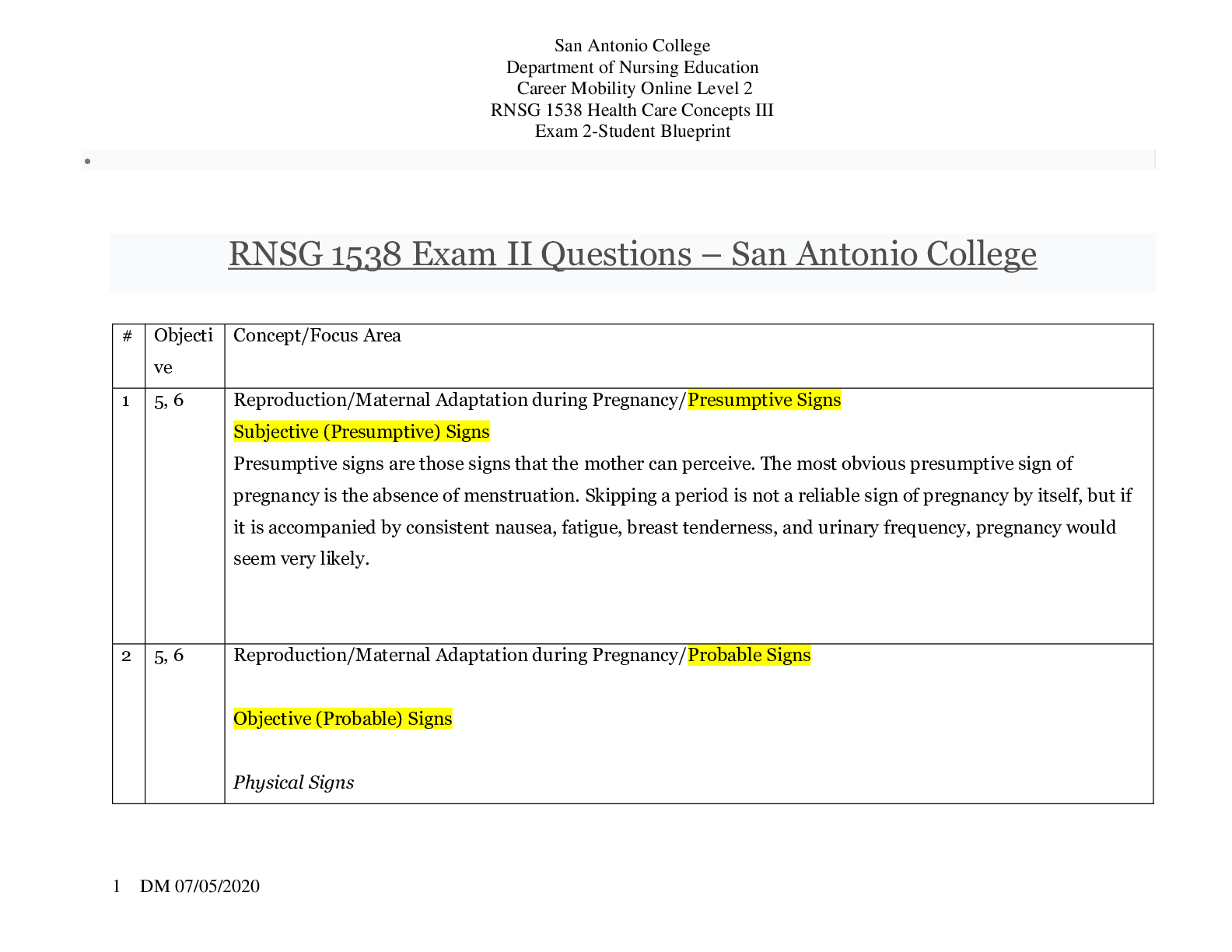
Buy this document to get the full access instantly
Instant Download Access after purchase
Add to cartInstant download
We Accept:

Reviews( 0 )
$12.50
Document information
Connected school, study & course
About the document
Uploaded On
Nov 09, 2020
Number of pages
81
Written in
Additional information
This document has been written for:
Uploaded
Nov 09, 2020
Downloads
0
Views
87















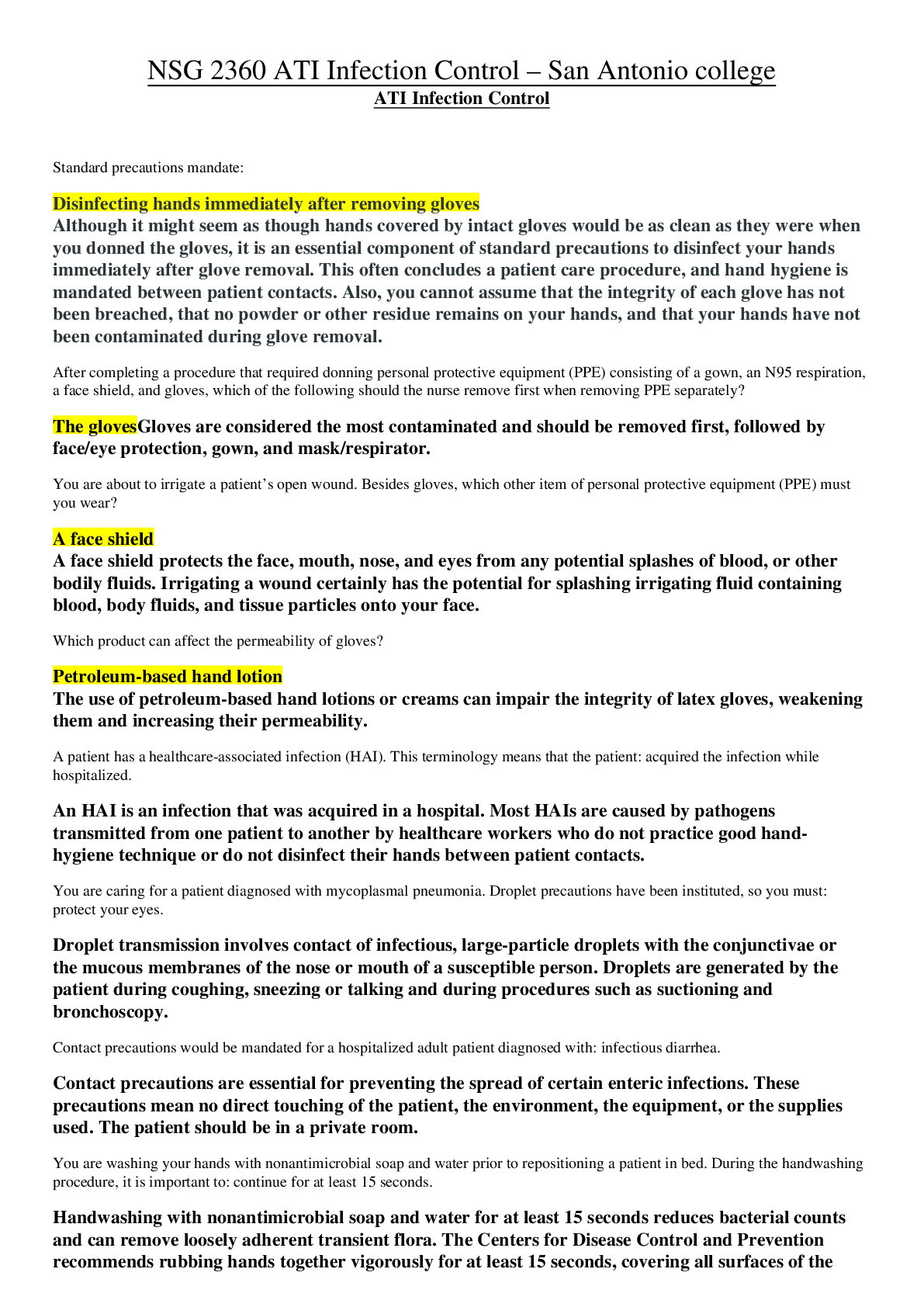
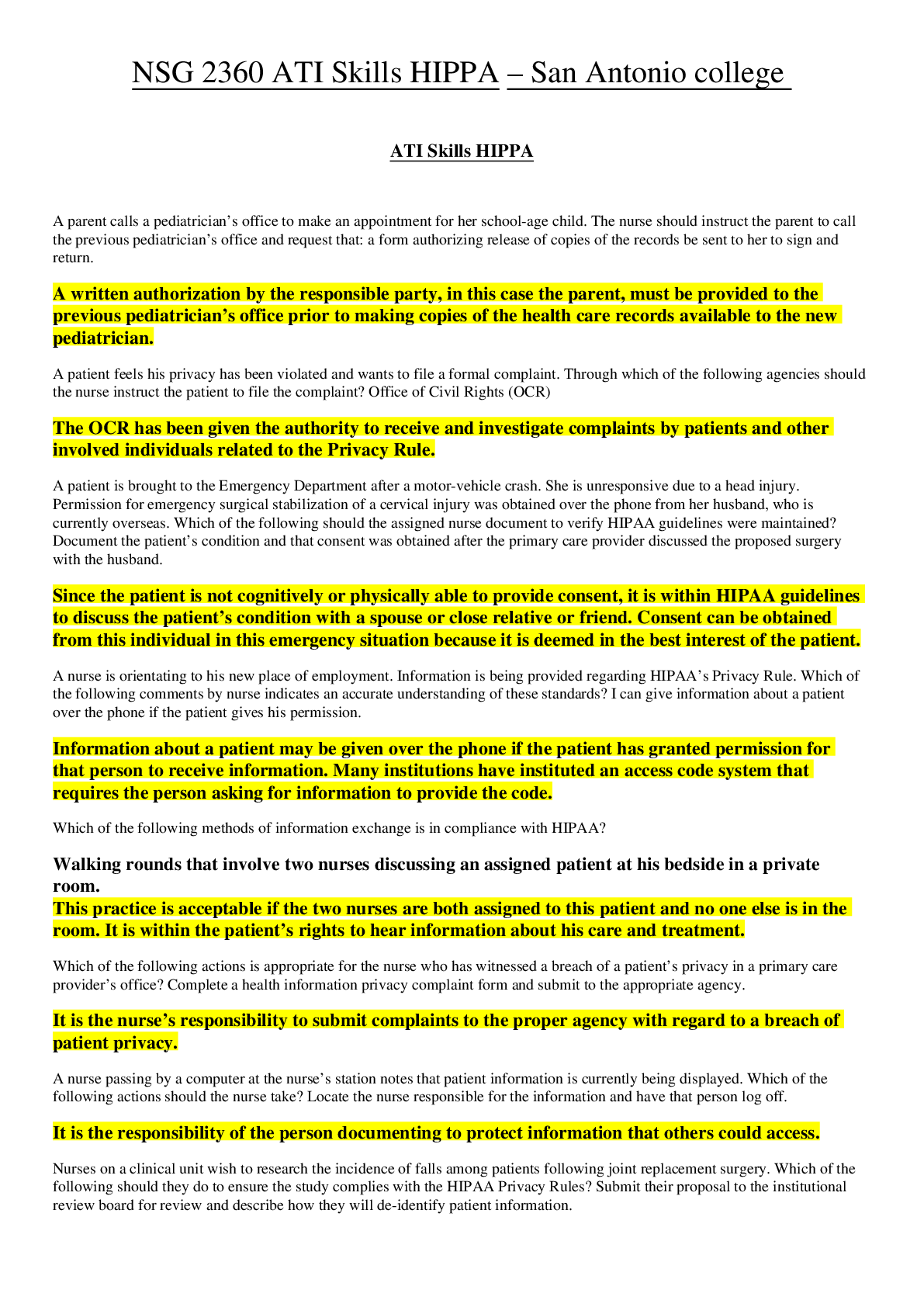
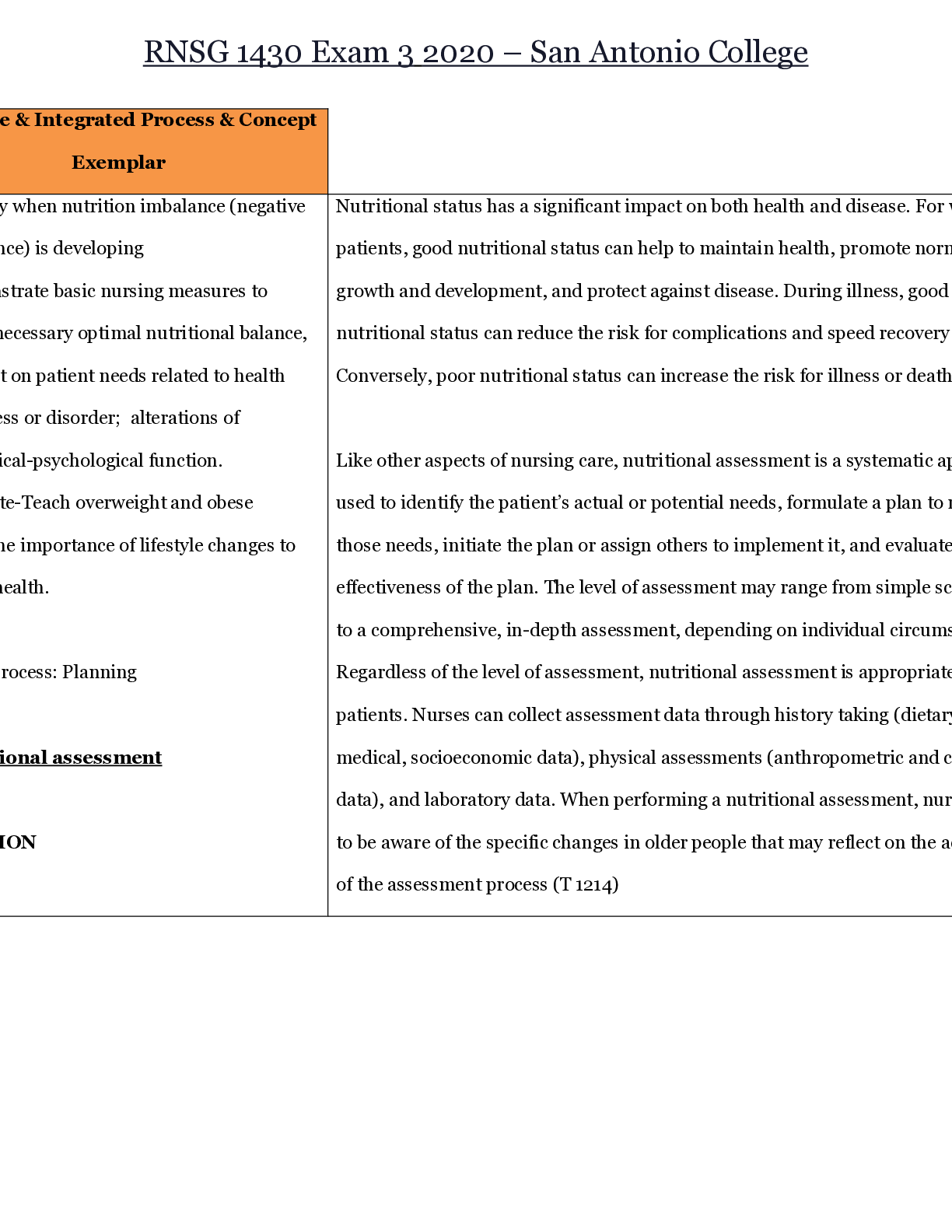

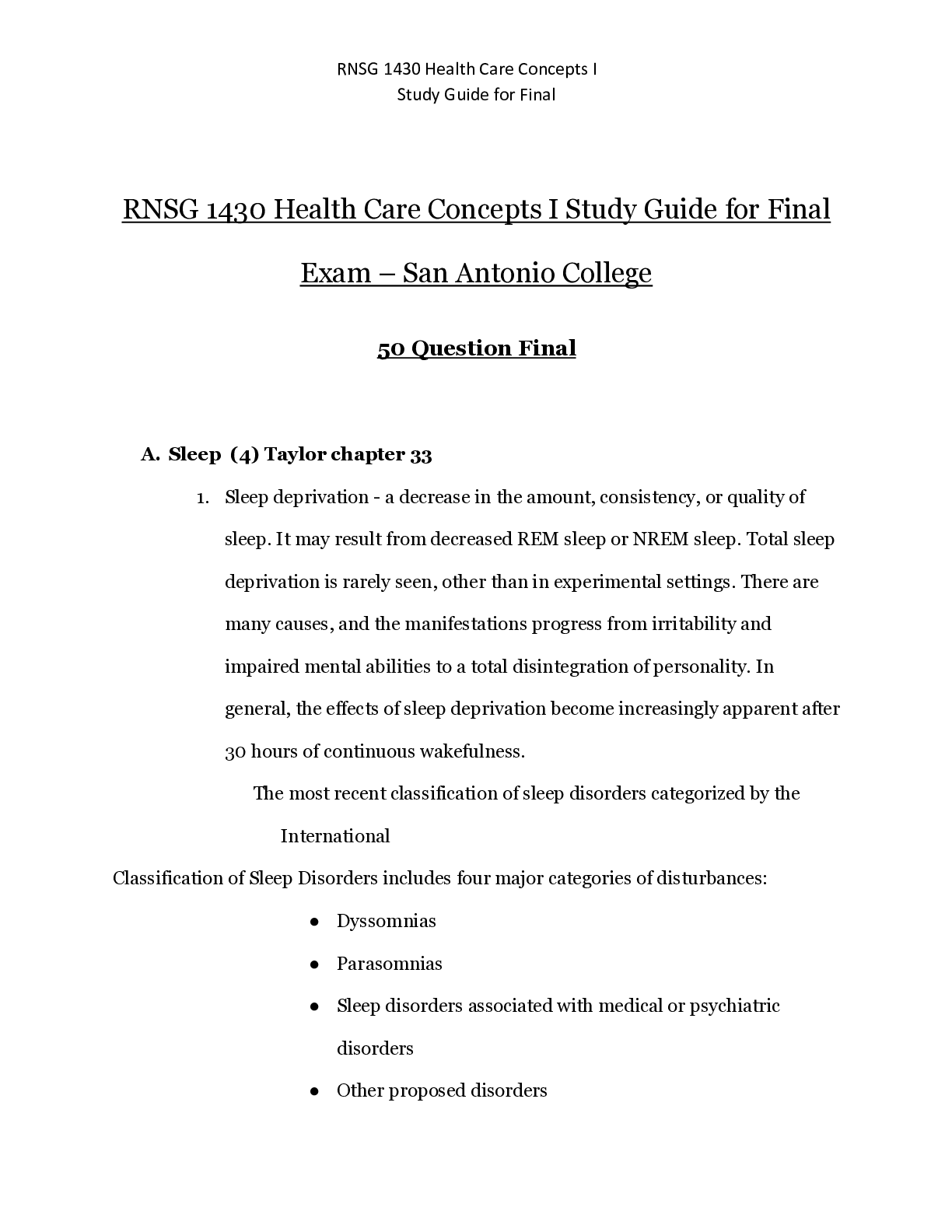
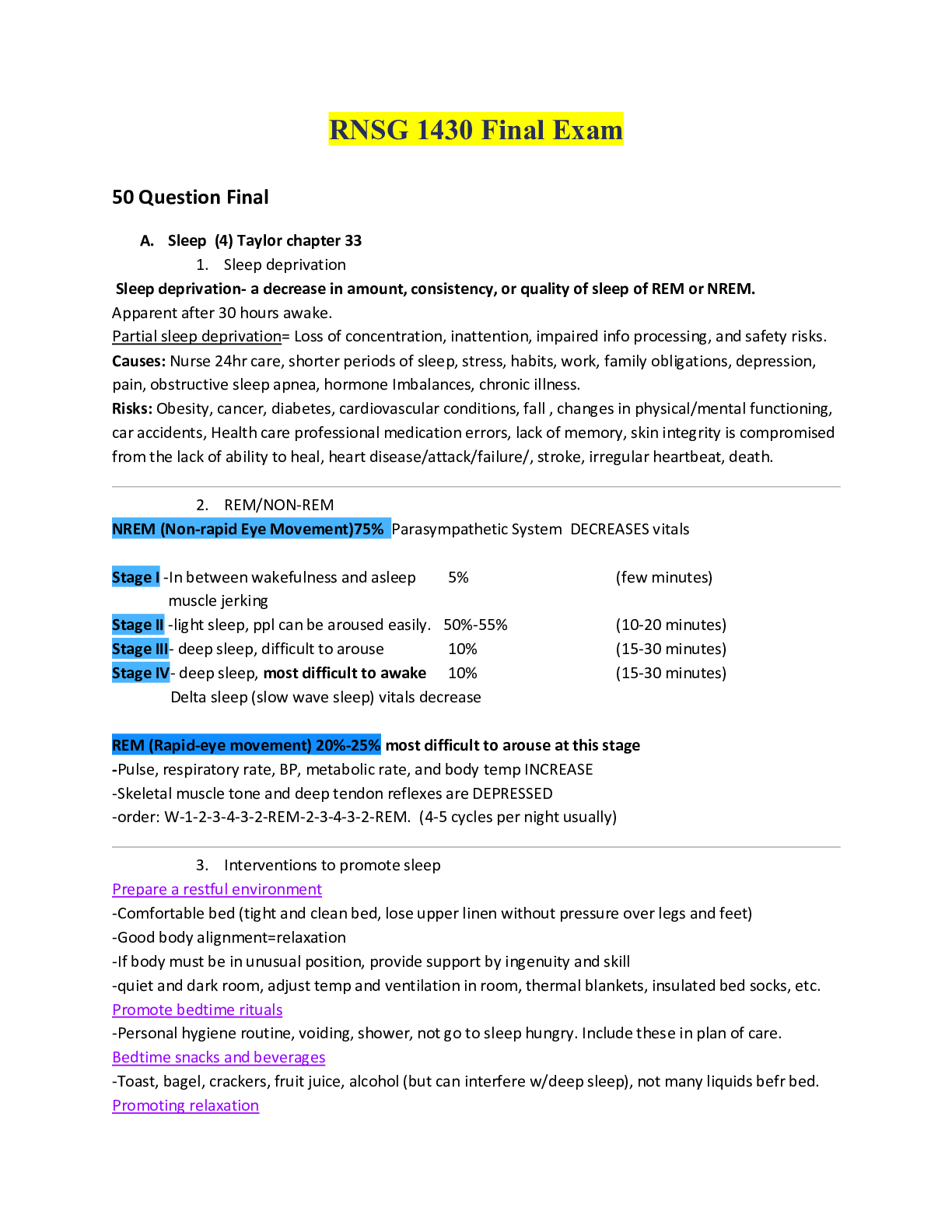
 – San Antonio College.png)
